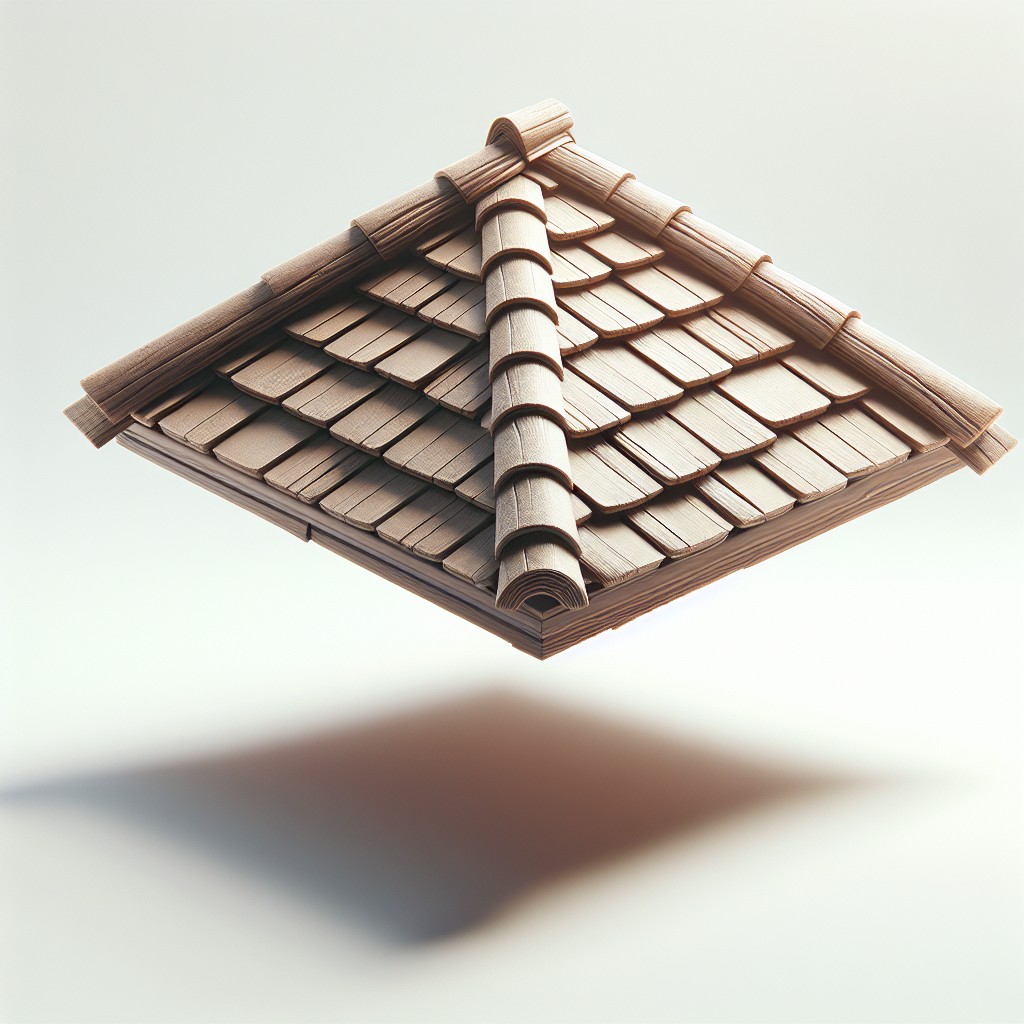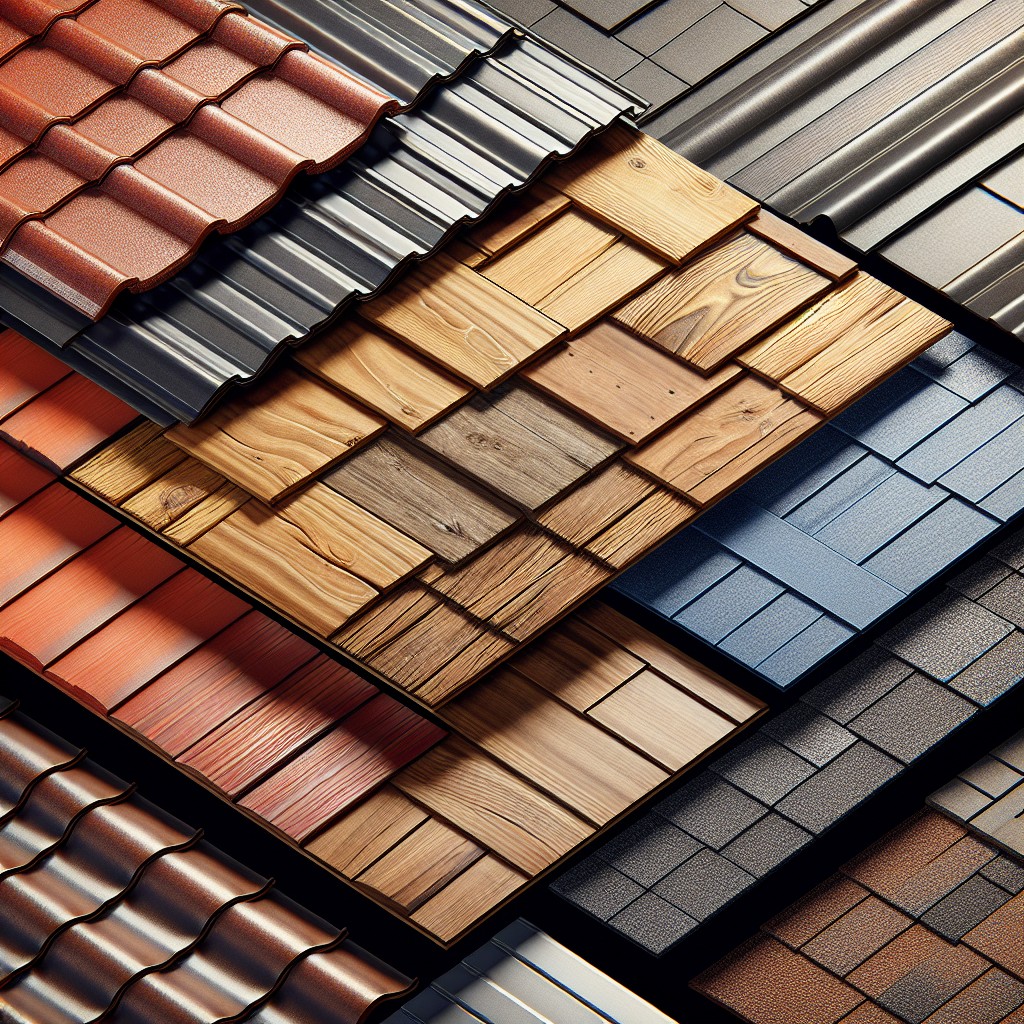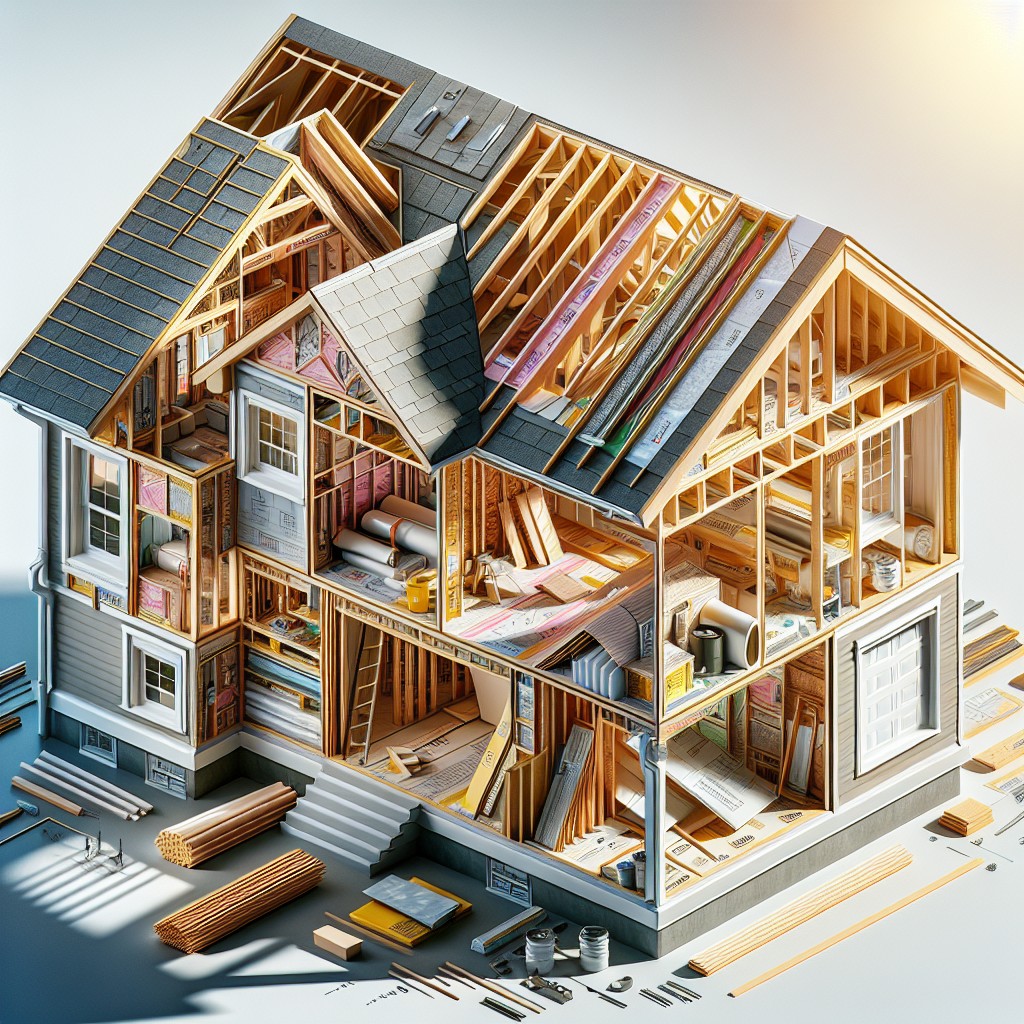Last updated on
Understanding the different elements of a roof piece is crucial because it allows homeowners to make informed decisions about roof repairs and replacements.
Understanding the various components that make up a roof is essential for maintaining the integrity of one’s home. From the protective granules of asphalt shingles to the structural support of trusses, each element plays a vital role in safeguarding against the elements.
Whether dealing with installation concerns or identifying signs of wear and damage, knowing the specifics about roofing materials, their functions, and the nuances of proper care can provide homeowners with the confidence to address roofing issues effectively.
This article delves into the intricacies of roofing parts and offers insights into recognizing and resolving common problems, ensuring your home remains secure and aesthetically pleasing.
Key takeaways:
- Roof pieces include shingles, tiles, underlayment, flashing, and trusses.
- Common materials for roof pieces include asphalt shingles, metal roofing, clay/concrete tiles, wood shakes, and synthetic materials.
- Roof pieces serve functions like waterproofing, support, ventilation, and aesthetics.
- Proper installation of roof pieces includes following manufacturer instructions, using the right tools, sequencing correctly, considering weather conditions, and secure attachment.
- Signs of roof piece damage or failure include missing/loose shingles, water stains, granules in gutters, sagging roof deck, daylight through the roof, and damaged flashing.
Definition of Roof Piece

A roof piece is a component of a roofing system that serves a specific function within the roof’s overall structure. Diverse in form and function, these components include shingles, tiles, underlayment, flashing, and trusses, among others.
Each plays a crucial role in waterproofing, support, and the aesthetic appeal of the roof. Some pieces, like tiles or shingles, are designed to be the first line of defense against the elements. By contrast, underlayment acts as a protective second layer. Flashing, typically made of metal, seals joints and prevents water intrusion, and trusses provide the underlying support necessary to maintain the roof’s shape and integrity.
These pieces work in tandem to ensure the roof’s durability and effectiveness in protecting a building from weather-related damage.
Common Materials for Roof Pieces

Roof pieces come in a variety of materials, each with their own set of characteristics and benefits. Asphalt shingles reign as a popular choice due to their cost-effectiveness and easy installation.
Metal roofing, on the other hand, offers durability and a longer lifespan, often reflecting sunlight to aid in energy efficiency. Clay and concrete tiles are favored in warmer climates for their thermal properties and distinct style, though they require a sturdier support system because of their weight.
Wooden shakes or shingles provide a natural aesthetic with decent insulation properties, but they demand more maintenance and can be susceptible to fire, pests, and rot. Synthetic materials such as rubber, plastic, and composite shingles are gaining ground due to their resilience, lightweight nature, and their mimicry of more expensive materials like slate or wood.
Speaking of slate, this premium material offers an elegant look with an impressive durability, often lasting over a century, but comes with a higher price tag and significant weight.
Each material must be selected based on the specific needs of the building, local climate, budget, and desired aesthetic. Quality underlayment and proper ventilation play a critical role in maximizing the performance and lifespan of any roof piece, regardless of the chosen material.
Types of Roof Pieces

Roof pieces vary greatly, each tailored to different structural and aesthetic requirements. Shingles, a ubiquitous option, are small, overlapping pieces typically made from asphalt, wood, or slate. Tiles, often clay or concrete, suit various climates due to their durability and insulation properties. Metal panels are prized for longevity and resistance to extreme weather, coming in large sheets or smaller, shingle-like pieces.
Other specialized types include cedar shakes, rustic and energy-efficient, and rubber roofing, which is durable and leakage-resistant. For flat roofs, built-up roofing (BUR) layers or membrane roofing materials, such as TPO or EPDM, offer robust protection. Architectural details, such as dormer windows and skylights, incorporate unique flashing pieces necessary to prevent water ingress at intersecting planes or openings.
Each type has its installation method and cost, balancing between performance and aesthetic appeal. It’s crucial to choose based on the roof’s slope, the climate of the area, and the home’s architectural style, ensuring the right fit for both function and design.
Function and Importance of Roof Pieces

Roof pieces serve as critical components in safeguarding homes and buildings from environmental elements. Their primary function is to provide a water-resistant barrier, directing precipitation away from the structure to prevent water ingress. This protection extends the longevity of a building’s frame and interior spaces, as well as improving energy efficiency by offering thermal insulation.
Moreover, roof pieces contribute to proper ventilation, allowing for air circulation that helps to mitigate moisture accumulation and reduce the likelihood of mold growth. They also play a role in the overall structural integrity of a roof. Interlocking pieces distribute weight evenly, prevent sagging, and withstand various loads, including snow or debris.
In terms of aesthetic appeal, roof pieces can significantly enhance a building’s visual aspect by providing a consistent, finished appearance. They often come in a variety of styles and colors, allowing customization to fit the architectural design of the property.
Lastly, well-installed and maintained roof pieces can result in reduced maintenance costs over time, highlight a commitment to safety by protecting residents from roof collapses or leaks, and can be a pivotal factor in insurance assessments, potentially lowering premiums due to decreased risk of damage.
Proper Installation of Roof Pieces
Ensuring roof pieces are correctly installed is crucial for the structural integrity and longevity of a roof. Here are some key points to consider during installation:
1. Follow Manufacturer Instructions: Every roofing material comes with a specific set of guidelines from the manufacturer. Adherence to these ensures optimal performance and validity of warranty.
2. Use the Right Tools: Specialized roofing tools facilitate proper fitting and securing of roof pieces, which minimizes potential damage during installation.
3. Sequencing Matters: Start from the bottom up. This overlap pattern helps in shedding water correctly, preventing leaks.
4. Weather Conditions: Ideal installation should be carried out in mild weather to avoid complications like improper sealing or difficulty in handling materials.
5. Secure Attachment: Nails, screws, and adhesives should be applied as recommended, ensuring that the roof pieces are fastened securely to resist wind uplift and other stresses.
6. Flashing Installation: Properly install flashing around penetrations and intersections to prevent water infiltration.
7. Allow for Movement: Roofing materials can expand and contract with temperature changes. It’s essential to allow for this movement to avoid cracks and breaks.
8. Align Correctly: Straight lines and proper alignment not only enhance aesthetic appeal but also ensure that the roof functions correctly.
9. Inspections: A thorough inspection post-installation can catch and rectify any errors before they lead to bigger problems.
Keep in mind that while DIY can be tempting, professional installation guarantees that roofing components are installed safely and effectively.
Maintenance and Repair of Roof Pieces
Regular maintenance extends the lifespan of your roof and ensures it remains protective and functional. Here are some key considerations:
- Inspect your roof biannually, and after severe weather events, to identify any damage or wear.
- Keep gutters clean to prevent water buildup that can cause roof damage.
- Replace broken or missing shingles promptly to avoid underlying structural damage.
- Check for moss or algae growth, which can degrade roofing materials, and treat as necessary.
- Ensure flashing is intact and sealed to prevent water leakage.
- Trim overhanging tree branches to reduce debris accumulation and physical damage to the roof.
- Look for signs of rust on metal roofs or accessories, and apply appropriate preventative measures.
- Attend to minor repairs swiftly to prevent them from escalating into major issues.
By following these maintenance tips, you can help prevent costly repairs and prolong the integrity of your roof.
Signs of Roof Piece Damage or Failure
Detecting early signs of damage or failure in your roof components can prevent minor issues from escalating into costly repairs. Look out for these indicators:
- Missing or loose shingles: Large gaps or flapping shingles suggest underlying damage.
- Water stains: Brown, yellow, or gray discoloration on your ceilings or walls often signifies a leak.
- Granules in gutters: An accumulation of shingle granules points to advanced wear.
- Sagging roof deck: A drooping or bowed roof deck indicates structural concerns.
- Daylight through the roof: Light visible in the attic suggests holes or severe cracks.
- Damaged flashing: Cracked or bent flashing around vents, chimneys, and skylights can lead to leaks.
Regularly inspecting your roof can catch these symptoms early, helping to maintain the integrity of your home.
Impact of Weather On Roof Pieces
Weather plays a pivotal role in determining the longevity and effectiveness of roofing materials. Extreme temperatures can cause materials to expand and contract, potentially leading to cracks or breaks over time. High winds may loosen roof pieces or lift them entirely, compromising the roof’s integrity.
Heavy rain can test the waterproofing capabilities of shingles and tiles, while prolonged exposure may result in leaks or rot. Snow and ice accumulation can exert significant weight on a structure, stressing joints and fasteners.
Sun exposure is another critical factor; UV rays can degrade certain materials, like asphalt shingles, leading to brittleness and a shorter lifespan. Hailstorms present a risk of denting or cracking roof pieces, necessitating swift assessment and repair to avoid subsequent water damage. Awareness and preparation for these weather conditions can aid in selecting appropriate materials and implementing preventative maintenance strategies to safeguard the roof’s durability.
Innovative Roof Piece Technologies
Emerging technologies in roofing are revolutionizing how roof pieces contribute to energy efficiency, durability, and smart home integration.
Photovoltaic Shingles blend seamlessly with traditional roofing materials while harnessing solar energy, effectively turning roofs into energy generators. These shingles offer a dual solution of protection and sustainable energy production without compromising aesthetics.
Cool Roofing Materials are designed to reflect more sunlight and absorb less heat than standard roof coverings. This advanced technology contributes significantly to reducing cooling costs and mitigating the urban heat island effect, providing both economic and environmental benefits.
Green Roofs, composed of vegetation layers over waterproof membranes, offer excellent insulation, help manage stormwater, and increase biodiversity. They are particularly valuable in urban settings for their ability to counteract the loss of green spaces.
Aerogel Insulation, although more commonly associated with space exploration, is making its way into roofing. The ‘frozen smoke’ material provides superb insulation in a thinner layer than conventional materials, allowing for lighter, more energy-efficient roof structures.
Smart Roof Systems are incorporating sensors and IoT connectivity to provide real-time data on roof conditions, enabling proactive maintenance and extending the lifecycle of roof components. This technology ensures timely detection and repair of issues, cutting down the long-term costs associated with roof maintenance.
Each of these technologies demonstrates the potential for roof pieces to transcend their traditional roles and offer enhanced functionality suitable for the modern world.
Sustainability and Eco-friendly Roof Piece Options
Embracing sustainable and eco-friendly options for roofing contributes significantly to reducing environmental impact. Materials like recycled shingles, derived from waste products like plastic, rubber, and wood fiber, offer longevity and durability comparable to traditional materials.
Metal roofing, with its high recyclability and energy efficiency, reflects sunlight, thereby reducing cooling costs and emissions. Solar shingles are another innovative avenue, integrating photovoltaic cells to harness solar energy, effectively turning roofs into renewable energy sources.
Green roofs, covered with vegetation, improve insulation, decrease stormwater runoff, and extend roof life by shielding roofing materials from the elements. Additionally, choosing light-colored roofs can mitigate the urban heat island effect, reflecting more sunlight and absorbing less heat.
When selecting eco-friendly roofing, it’s crucial to consider the product’s lifecycle, from manufacturing and installation to maintenance and eventual disposal or recycling, to ensure a truly green roofing solution.
Roof Piece Warranty and Lifespan
The durability of your roof is a paramount concern, often reflected in the warranty provided by the manufacturer. Typically, warranties range from 15 to 30 years, but some high-end materials can be guaranteed for a lifetime. It’s essential to understand that a warranty’s coverage can vary significantly, with some policies only covering the materials while others include labor costs for repairs.
Key points to consider about warranties and lifespan are:
- Material Matters: The type of material used greatly influences the warranty period. For instance, asphalt shingle warranties might cover 15-30 years, while metal or tile roofs may offer up to 50 years of coverage.
- Warranty Types: There are manufacturer’s warranties that cover defects in the roofing material and workmanship warranties from the installer that cover installation errors. Always clarify what your warranty covers.
- Transferability: Some warranties are transferable to new homeowners, which can be a selling point if you plan to move within the warranty period.
- Maintenance Requirements: Warranties often require regular maintenance to remain valid. Make sure to adhere to these guidelines to not void the warranty.
- Proration: Be aware that some warranties are prorated, meaning the coverage value decreases over time.
To get the full benefit of a roof warranty, ensure proper installation by a certified professional and regular maintenance. Always keep documentation of your warranty and any roof repairs or inspections, as you may need them to validate a warranty claim.
Aesthetic Considerations for Roof Pieces
The appearance of your roof can significantly affect the curb appeal of your property. Selecting materials and colors that complement the architectural style of your home will create a harmonious look. Traditional homes often pair well with classic materials like slate or wood shakes, while metal or rubber shingles might better suit modern structures.
Color is another crucial element. Lighter colors can reflect sunlight and keep your home cooler, beneficial in warmer climates, while darker hues retain heat, ideal for colder regions. Consider the color of your home’s exterior; a contrasting roof color can highlight your home’s features, whereas a harmonious color scheme can blend seamlessly with the surroundings.
Texture and pattern also play roles in the aesthetic impact. Dimensional shingles, for example, add depth and interest to a roofline, mimicking the look of natural materials. On the other hand, flat tiles can impart a sleek, clean appearance to the structure.
Lastly, keep in mind the roof’s visibility. If it’s highly visible, investing in premium materials and design can add to the overall architectural beauty. If less visible, functional considerations might outweigh aesthetic nuances. Remember to adhere to any homeowners’ association guidelines and local building codes when making your selections.
Regulations and Building Codes for Roof Piece Installation
Navigating the labyrinth of regulations and building codes is essential for ensuring the safety, durability, and legal compliance of your roofing project. These rules vary by location, but typically address factors such as:
- Structural Load: Codes determine the weight a roof must withstand, factoring in snow, ice, and wind.
- Fire Resistance: Requirements are set for materials’ fire ratings to minimize the spread of flames.
- Wind Uplift: Standards ensure that roof pieces can resist high winds, especially in hurricane-prone areas.
- Material Specifications: Codes may restrict certain materials based on the local climate or environmental considerations.
- Installation Methods: There are specific guidelines on how to properly secure roof pieces to the structure.
- Energy Efficiency: Some regions have insulation requirements to enhance energy conservation.
- Historical Preservation: Special codes might apply in historical districts to maintain architectural integrity.
Always consult with local building authorities or a licensed roofing professional to understand and adhere to the applicable codes in your area. This proactive approach will aid in achieving a compliant and secure roofing system.
FAQ
Why do people call it roof piece?
The term "roof piece" is often used humorously to highlight the extended duration and intensity of the battle that takes place on the roof in a particular manga or anime series.
Who was at roof Piece?
The individuals present at the roof piece were Kaido, Big Mom, Luffy, Zoro, Law, Kid, and Killer.
Why is Onigashima flying?
Onigashima is flying because it was displaced from its original spot at sea by Kaidou using his dragon powers as part of the New Onigashima Project, intending to move it to the Flower Capital.
What are the characteristic features of a roof piece in architecture?
In architecture, the characteristic features of a roof piece encompass its design, material, color, insulation, durability, and its ability to withstand different weather conditions.
How does roof piece contribute to overall building insulation?
Roof pieces, such as tiles or shingles, contribute to overall building insulation by creating a thermal barrier that regulates interior temperatures and reduces energy usage.
What common issues do homeowners face with roof pieces and their maintenance?
Common issues homeowners typically face regarding roof pieces and maintenance involve leaks, poor installation, and inadequate maintenance leading to deterioration and damage over time.




